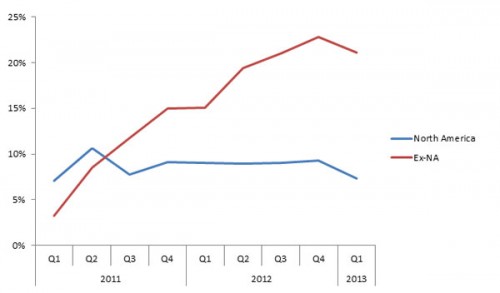Is 3D TV Dying in The U.S.?
By Paul Gagnon
DisplaySearch
3D TV is back in the news, but not in a good way. This morning, an ESPN PR spokesperson announced in a tweet that they were discontinuing 3D to focus on other things, like UHD. This move had been rumored for some time in the tech press, stemming from a 2011 decision by AT&T U-Verse to stop carrying 3D channels and a significant lack of 3D news coming from ESPN recently as it announced its fall college football coverage.
But really… is anyone surprised?
Over the last year, as demonstrated in DisplaySearch TV shipment data, 3D has shown no real growth in the North America market. Meanwhile, in other parts of the world, 3D has continued to grow, although that growth has recently tailed off a bit.
Figure 1 – 3D Share of TV Shipments (DisplaySearch)
The reason for the poor adoption in what many considered to be the best market for 3D? I believe there are a multiple reasons for the low interest:
3D, as a feature, one that is often offered with other features, still carries a hefty premium and U.S. consumers have been very unwilling in recent years to spend more for features when they can get a large size instead. The average 3D premium for a 55” TV in North America was more than 40 percent in Q1’13, almost exactly the same as it was in Q1’11. US consumers seem to be far more price sensitive than other regions.
Burden of 3D glasses. Consumers have cited the expense and inconvenience of having to use 3D glasses, of any type, in order to view 3D programs. Given a choice, most consumers would prefer glasses-free 3D TVs, but the technology is a long way from being consumer friendly.
Demonstrations at retail are often not functioning properly.
Consumers in the U.S. have been exposed to 3D at home many times in the past (anyone remember red/green anaglyphic glasses that used to come in cereal boxes?) and the experience has been poorly received. This time around, there is a fair bit of skepticism. In other parts of the world, 3D at home is a fairly new experience and the level of wonder and optimism for content is probably sustaining demand.
Finally, content has been very limited, even 3 years after the launch. Few live programs are available in 3D and most of what is available (exclusive of 3D Blu-Ray releases) is from a limited range of material that is re-run often.
It’s understandable that content creators are hesitant to continue investing in costly new technologies if the viewer base is not growing at an attractive rate. However, this move by ESPN might signal that the momentum has shifted away from 3D in the U.S. and TV manufacturers and retailers would be wise to take note.
This article was reprinted with permission from DisplaySearch and originally appeared here.






